2025 October 9 — South Pole Observatory and PreSAT meetings at University of Chicago

We had a productive three day meeting at University of Chicago. The first two days were focused on joint analysis of BICEP and South Pole Telescope data. We are particularly thinking about how to use lensing maps constructed from SPT data to delens BICEP, but discussions also covered the use of SPT polarization data at low ℓ and working together on other analyses such as cosmic birefringence. On day three, we switched gears to have a technical review of the fourth BICEP Array telescope, known either as PreSAT or BA4. This telescope is scheduled for shipment to the South Pole in fall 2026—there is a lot to get done between now and then!
2025 March 26 — CMB-S4 collaboration meeting at UC Berkeley

We just wrapped up a three-day CMB-S4 collaboration meeting at UC Berkeley. This meeting happened at a very critical time for the project, since we are completing two major reports -- one defining a redesigned CMB-S4 project that can accomplish all of our science goals with telescopes in Chile and another that surveys the landscape of CMB experiments over the next decade. In addition to reviewing and discussing these reports, this meeting had lots of interesting discussion about the future path of CMB-S4. More on this topic to come...
2024 December 6 — HEPAP presentation on South Pole CMB
I gave a presentation to the High Energy Physics Advisory Panel (HEPAP) about the advantages of the South Pole of CMB polarization measurements focused on inflation science. You can see the slides here and a video recording here (my talk comes first on the recording).
This talk (and the companion talk from Toby Marriage about CMB polarization measurements from Chile) was requested by HEPAP to help understand the impact of NSF's decision to not allow CMB-S4 to proceed with plans involving South Pole. My presentation includes forecasts for what could be achieved through upgrades of the existing BICEP Array and South Pole Telescope, without the need for expanded infrastructure at the Pole.
2023 December 7 — CMB-S4 highly endorsed in P5 report
Today the Particle Physics Project Prioritization Panel (P5) released their decadal report, which can be downloaded here. This report supported the construction of five new large projects and gave the highest priority to CMB-S4! A nice summary of the recommended new large projects can be found in this Nature news article.
2023 September 7 — Crawford Hill horn antenna
There was a nice article by Dennis Overbye in the New York Times, Where the Universe Began, that describes the Crawford Hill horn antenna where Arno Penzias and Bob Wilson discovered the Cosmic Microwave Background in 1964. If you scroll partway down the page, you will find a photo of the seven-meter antenna, which hosted the CAPMAP experiment from 2002–2005. That telescope is now in severe disrepair (unlike the horn antenna, which has historical significance!) but I spent my first several years of grad school working on CAPMAP and have lots of fond memories of watching it scan in slow rings on New Jersey winter nights.
2023 July 25 — BICEP Collaboration Meeting
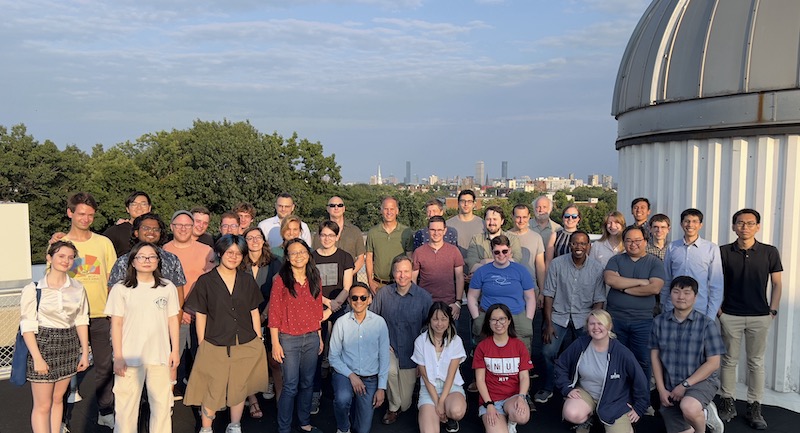
Last week was the 2023 BICEP Collaboration Meeting, held at Harvard. It was a lot of fun seeing everyone, even with tough decisions to make about our upcoming deployment season. Some highlights were hearing from Baibhav and Silvia about performance of the latest BICEP Array telescope, updates on SPT study of polarized atmospheric emission from Anna and Jessica, and ground scan movies from Christos. We also had interesting discussions of how to improve collaboration climate and the wide range of analysis projects that we hope to pursue in the coming year.
2023 June 30 — Congratulations Dr. Hand!
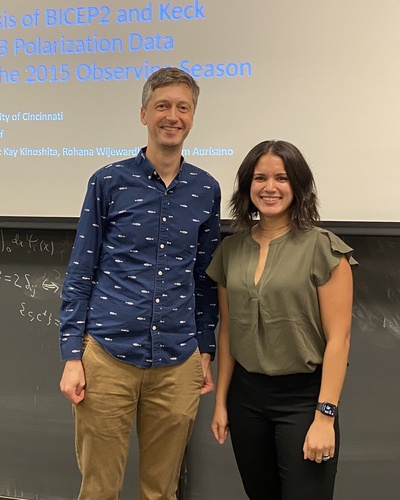
Emma successfully defended her PhD thesis, which was titled “ILC Analysis of BICEP2 and Keck Array CMB Polarization Data through the 2015 Observing Season”. The Internal Linear Combination (ILC) analysis method involves making a weighted linear combination of maps at many observing frequencies with weights chosen to minimize both noise and foreground contamination in the resulting map. In addition to constructing ILC maps from this dataset, Emma did extensive work to construct a likelihood that yields unbiased constraints on r, even in the presence of poorly understood foregrounds.
Emma is starting a new job next week as a data scientist at Proctor and Gamble. She will still be in the Cincinnati area, so hopefully will drop by and visit our group in the future.
2023 March 20 — South Pole deployment update
The 2022–2023 austral summer season completed a little over a month ago. This is always a busy time for the BICEP project; from early November to mid-February is the only time that collaboration members can travel and ship cargo to the South Pole. This year was especially busy because we deployed the second out of four BICEP Array telescopes. BA2 will eventually contain nearly 7800 detectors (3888 dual-polarization pixels), all observing in a frequency band centered at 150 GHz (∼2 mm wavelength). Currently, only five out of 12 detector tiles are installed in BA2; we plan to complete the focal plane next deployment season.
The photograph below shows the BA2 focal plane with five modules installed, but before it was sealed up inside its cryostat. Members of the BICEP deployment team are (left to right): Silvia Zhang (Caltech), Sofia Fatigoni (Caltech), Alessandro Schillaci (Caltech), Jamie Cheshire (Minnesota), and Matthew Petroff (Harvard). This photograph was taken in the Martin A Pomerantz Observatory (MAPO) at the South Pole.
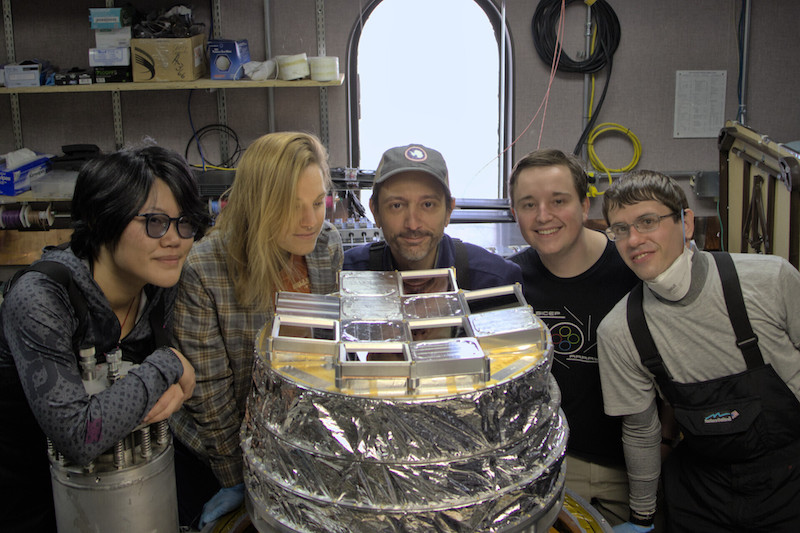
Next, we have a view of BICEP Array from the roof of MAPO after installing the BA2 telescope. The two large cylinders with black interiors are forebaffles attached to the front of BA1 and BA2 in order to block stray light. Behind these large forebaffles, you can see a glimpse of two Keck Array telescopes that are still operating in the BICEP Array mount. Members of the BICEP deployement team are (left to right): Baibhav Singari (Minnesota), Anthony DeCicco (BICEP Array winter-over), Bryan Steinbach (Caltech), Clem Pryke (Minnesota), and Matthew Petrov (Harvard).
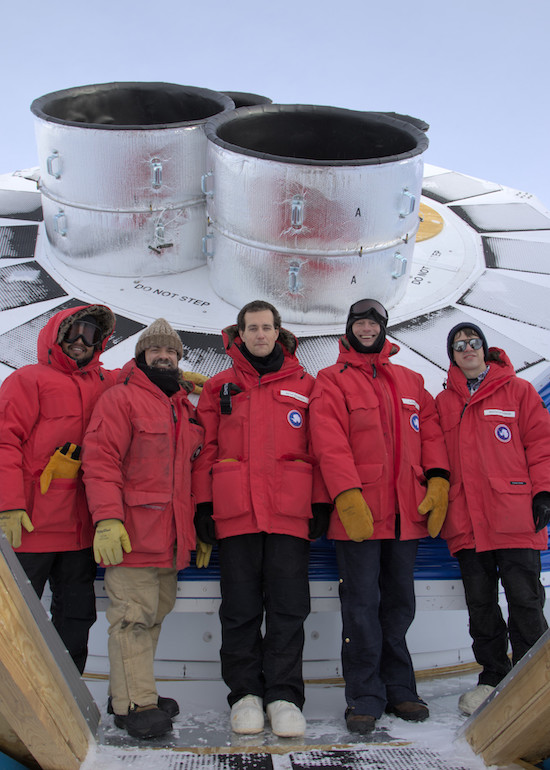
Both BICEP Array and BICEP3 are currently taking calibration data to study the optical response of the telescopes. Amundsen-Scott South Pole Station has been closed for a little over four weeks and our brave winter-overs (Anthony DeCicco and Manwei Chan) are responsible for keeping the instruments running through the cold and dark for the next seven months!
2022 November 7 — South Pole lunar eclipse on APOD
SPT winter-over Aman Chokshi strikes again with this view of a lunar eclipse over the Dark Sector Laboratory, South Pole Telescope, and BICEP3. It was taken back on May 16 during the austral winter. Since late September, the Sun has risen above the horizon at the South Pole and BICEP team members are currently en route for installation of the second BICEP Array telescope!
2022 November 4 — CMB-S4 Analysis of Alternatives
There is a nice article in Symmetry magazine that describes the science goals and current status of the CMB-S4 project. A major current activity is to evaluate whether we can achieve our inflation science goal using designs that have a smaller infrastructure footprint at the South Pole. Today these designs, their cost estimates, and the science forecasts are being presented to a panel of external scientists at a small meeting in Chicago. The goal of this meeting is to demonstrate that we are ready to move forward with more detailed design and, eventually, construction!
The goal of this news item on the Cincinnati CMB website is for me to put a pin in my exhaustion after running forecast after forecast after forecast.
2022 August 8 — Building calibration hardware
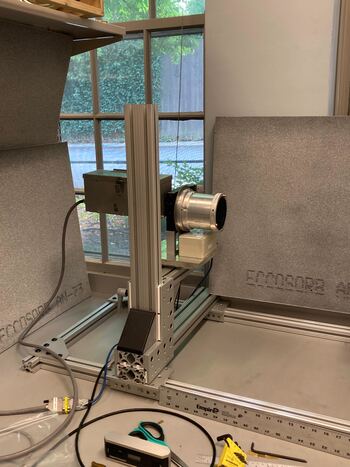
Christos just spent two week at Harvard, building and testing broad-spectrum noise sources to use for BICEP Array and BICEP3 calibration. These sources broadcast amplified thermal noise in frequency ranges measured by our instruments (95 GHz for BICEP3; 30, 40, or 150 GHz for BICEP Array). This acts as a bright point source that can be chopped on and off to improve our rejection of backgrounds and produce clear beam maps. The source is linearly polarized, and can be incorporated into a rotating polarized source (RPS) with a wire grid and a rotation stage.
In addition to working on the broad-spectrum noise sources, Christos also trained on using a large chopped thermal source (unpolarized). All of this calibration equipment will be put to use in January and February 2023, when Christos travels to the Amundsen-Scott South Pole Station to work on BICEP3 and BICEP Array!
2022 August 5 — Congratulations Kyle!
Kyle Weeks just successfully defended his masters thesis, titled “The BICEP Array Housekeeping System and Calibration of the Daughter Cards.” His work focused on improving the calibration of electronics used to monitor temperatures throughout the BICEP Array cryostats and to understand how calibration errors propagate to errors on temperature measurement.
2022 July 8 — Visiting BA2

Spent the past week at Caltech, where they are getting the second BICEP Array telescope ready for deployment to the South Pole. In the photo, you can see the cryostat, which contains the refracting telescope, Helium sorption fridge, and focal plane with 150 GHz detector modules. The photo doesn't include a human for scale, but this thing is about three meters tall, including the lab cart.
BA2 was in the process of cooling down for an optical test run, so work was focused on the data acquisition system, testing the deployment housekeeping electronics (which read thermometers and control heaters throughout the cryostat), and preparing the calibration hardware that will be used in the run.
When BA2 is deployed with a full focal plane, it will contain nearly 8000 detectors and should achieve 15× faster mapping speed than one of the Keck Array 150 GHz telescopes. One year of observations with BA2 could exceed the entire 150 GHz sensitivity accumulated by BICEP2 and Keck Array from 2010 through 2016!
2022 May 18 — BICEP collaboration meeting
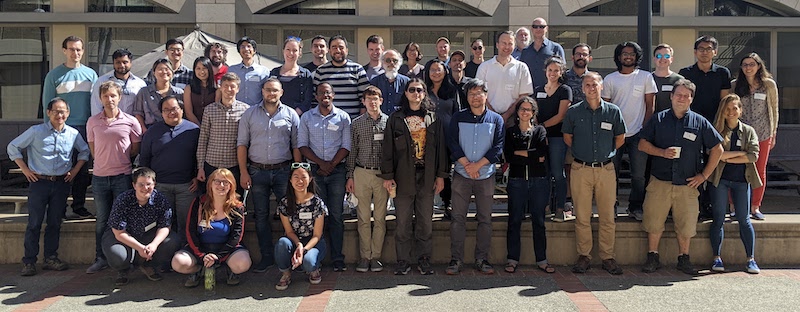
We just wrapped up a great three day BICEP collaboration meeting at Stanford. This was the first time that we have all gotten together since 2019. It was great to see old friends, meet new team members, and have some really productive discussions. Major topics of the meeting included the detector and readout scheme for the BA4 telescope, schedule for the upcoming deployment season, our continuing joint analysis efforts with South Pole Telescope, and a session devoted to climate and DEI issues.
2021 Dec 11 — South Pole eclipse on APOD
BICEP3 and the South Pole Telescope were featured on the NASA Astronomy Picture of the Day! There was a partial solar eclipse viewable from Antarctica on December 4. SPT winter-over Aman Chokshi took this awesome time lapse photo showing the progress of the eclipse with BICEP Array winter-over Brandon Amat and BICEP grad student Cheng Zhang included for scale.
2021 Oct 4 — BK18 results paper
The latest BICEP results are out now on arXiv and PRL and the data release posted to bicepkeck.org. We refer to this paper as “BK18” because it incorporates all BICEP/Keck Array data up through our 2018 observing season. Compared to our previous results paper (BK15), the headline constraint on r (the tensor-to-scalar ratio) has improved by a factor of two—the one sigma error bar has decreased from 0.02 to 0.009. This jump forward in sensitivity is due to new data at 95 GHz from BICEP3 and 220 GHz from Keck Array. We still find that our simple parametrized model of foregrounds and CMB is adequate to explain the data and there is no detection of synchrotron emission.
2021 July 14 — Congratulations Dr. Palladino!
Steve Palladino just successfully defended his PhD thesis, titled “Constraining Primordial Gravitational Waves with BICEP/Keck Array Telescopes and Developing the BICEP Array Housekeeping System.” A large part of Steve's graduate work was the design, fabrication, characterization, and deployment of an electronics system used to monitor and control the cryogenic performance of the BICEP Array cryostats. This system is currently in use by BA1 at the South Pole as well as the other BICEP Array receivers in development in North America.
Steve also worked on some details of the likelihood used for high-level analysis of BICEP/Keck power spectra, particularly studies of the bandpower covariance matrix. He developed a variant of our parametrized likelihood analysis that uses an interative estimator for r, allowing us to make fewer assumptions about the form of the likelihood function and to calculate frequentist confidence intervals.